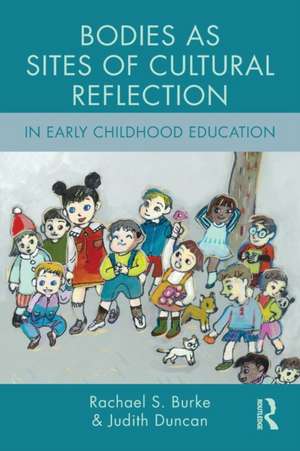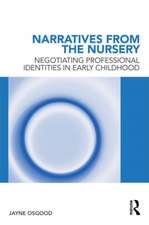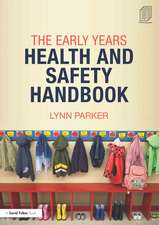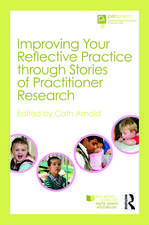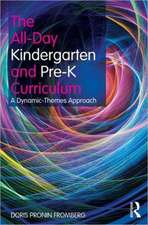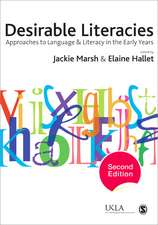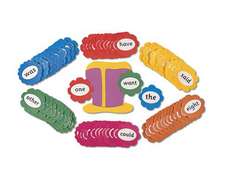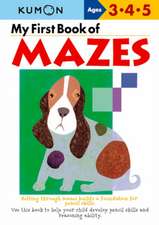Bodies as Sites of Cultural Reflection in Early Childhood Education: Changing Images of Early Childhood
Autor Rachael S. Burke, Judith Duncanen Limba Engleză Paperback – 20 noi 2014
Bodies as Sites of Cultural Reflection in Early Childhood Education uses empirical examples from qualitative fieldwork conducted in New Zealand and Japan to explore these theories and discuss the ways in which children’s bodies represent a central focus in teachers’ pedagogical discussions and create contexts for the embodiment of children’s experiences in the early years.
| Toate formatele și edițiile | Preț | Express |
|---|---|---|
| Paperback (1) | 381.72 lei 6-8 săpt. | |
| Taylor & Francis – 20 noi 2014 | 381.72 lei 6-8 săpt. | |
| Hardback (1) | 1162.08 lei 6-8 săpt. | |
| Taylor & Francis – 28 noi 2014 | 1162.08 lei 6-8 săpt. |
Preț: 381.72 lei
Nou
Puncte Express: 573
Preț estimativ în valută:
73.05€ • 79.32$ • 61.36£
73.05€ • 79.32$ • 61.36£
Carte tipărită la comandă
Livrare economică 22 aprilie-06 mai
Preluare comenzi: 021 569.72.76
Specificații
ISBN-13: 9781138795044
ISBN-10: 1138795046
Pagini: 200
Dimensiuni: 152 x 229 x 15 mm
Greutate: 0.27 kg
Ediția:1
Editura: Taylor & Francis
Colecția Routledge
Seria Changing Images of Early Childhood
Locul publicării:Oxford, United Kingdom
ISBN-10: 1138795046
Pagini: 200
Dimensiuni: 152 x 229 x 15 mm
Greutate: 0.27 kg
Ediția:1
Editura: Taylor & Francis
Colecția Routledge
Seria Changing Images of Early Childhood
Locul publicării:Oxford, United Kingdom
Cuprins
LIST OF FIGURES
FOREWORD
ACKNOWLEDGEMENTS
NOTE ON AUTHORS
GLOSSARY OF KEY TERMS
SERIES EDITOR INTRODUCTION
CHAPTER 1: Introduction
Introduction
Personal Connections
Theoretical Underpinnings
Marcel Mauss and the emergence of the body in anthropological theory.
The work of Mary Douglas.
Michel Foucault and the body.
The three bodies.
Methodology Behind the Scenes
The Field
Field site structure and daily routines.
Fieldwork methods.
The Development of Early Childhood Services in New Zealand and Japan
New Zealand.
Japan.
Bodily Practices.
Outline of the Book
Chapter References
Chapter Endnotes
CHAPTER 2: Children’s Bodies as Contested Sites
Introduction
The Un(clothed) Body
The naked child in Japanese educational settings.
The Japanese Child’s Body as a Symbol of Nostalgia
Skinship as cultural ideology.
The collective unclothed body.
The Protected Body in New Zealand Early Childhood Education
Bodies under surveillance.
Normalising the clothed body.
Keeping the Japanese Child’s Body Safe
Framing the Child’s Body
Notions of privacy.
The Body as a Site of Excretion
The body as teacher in Japanese early childhood education.
Reflecting on Children’s Bodies as Culturally Contested
Chapter References
Chapter Endnotes
CHAPTER 3: Embodying the Curriculum
Introduction
Engaging the Body in Sensory Play
Wrapping and unwrapping the body.
Messy play.
The Body as a Counterpoint to Modern Lifestyles
Body Techniques
The cultural meanings of touch.
The body as a medium of communication.
The Physical Self
Embodying gambaru in the Japanese context.
Reflections on Embodying the Curriculum
Chapter References
Chapter Endnotes
CHAPTER 4: Risk and the Body
Introduction
Towards a Discourse of Risk
The Position of Children in the Risk Society
Perilous Play: The Kindergarten Playground as Culturally Contested Space
A Pedagogy of Risk
Creating Real and Imagined Boundaries to Minimise Risk
Cultural Definitions of Safe Supervision
The low profile of Japanese teachers.
The use of real tools.
Tools as iconic symbols.
Assessing the risks and rewards of real tools.
Defining objects in play as safe or risky.
Perceptions of Risk and the Body
Chapter References
Chapter Endnotes
CHAPTER 5: The Body as a Site of Discipline
Introduction
Deconstructing Noise
Noise as counterproductive.
Noise as organic.
Conflict and Confrontation
Rights discourses in New Zealand.
The lessons of conflict.
Learning communicative competency.
Developing empathy.
The Use of Time and Space
Time and space as disciplinary techniques in the Japanese kindergarten.
Children’s Bodies as Objects of the Medical Gaze
Reflecting on the Body as a Site of Discipline
Chapter References
Chapter Endnotes
CHAPTER 6: The Body as Natural Symbol
Introduction
Dirt and the Body
The Physical Body as a Microcosm of Society
The Symbolism of Protective Barriers
Bodily Fluids as Metaphors of Disorder
Purification of the Body
Polluted spaces.
Food In and Out of Place
Rituals around food.
The lunchbox as a reflection of cultural ideology.
Reflecting on Constructions of Dirt, Pollution and Purity
Chapter References
Chapter Endnotes
CHAPTER 7: Bodies in Context
Introduction
Bodies from the Beginning
Constructing the body.
The body and its products.
Internalising techniques of the body.
Order and the body.
Approaches to Dirt and Pollution
Coming Full Circle
Chapter References
INDEX
FOREWORD
ACKNOWLEDGEMENTS
NOTE ON AUTHORS
GLOSSARY OF KEY TERMS
SERIES EDITOR INTRODUCTION
CHAPTER 1: Introduction
Introduction
Personal Connections
Theoretical Underpinnings
Marcel Mauss and the emergence of the body in anthropological theory.
The work of Mary Douglas.
Michel Foucault and the body.
The three bodies.
Methodology Behind the Scenes
The Field
Field site structure and daily routines.
Fieldwork methods.
The Development of Early Childhood Services in New Zealand and Japan
New Zealand.
Japan.
Bodily Practices.
Outline of the Book
Chapter References
Chapter Endnotes
CHAPTER 2: Children’s Bodies as Contested Sites
Introduction
The Un(clothed) Body
The naked child in Japanese educational settings.
The Japanese Child’s Body as a Symbol of Nostalgia
Skinship as cultural ideology.
The collective unclothed body.
The Protected Body in New Zealand Early Childhood Education
Bodies under surveillance.
Normalising the clothed body.
Keeping the Japanese Child’s Body Safe
Framing the Child’s Body
Notions of privacy.
The Body as a Site of Excretion
The body as teacher in Japanese early childhood education.
Reflecting on Children’s Bodies as Culturally Contested
Chapter References
Chapter Endnotes
CHAPTER 3: Embodying the Curriculum
Introduction
Engaging the Body in Sensory Play
Wrapping and unwrapping the body.
Messy play.
The Body as a Counterpoint to Modern Lifestyles
Body Techniques
The cultural meanings of touch.
The body as a medium of communication.
The Physical Self
Embodying gambaru in the Japanese context.
Reflections on Embodying the Curriculum
Chapter References
Chapter Endnotes
CHAPTER 4: Risk and the Body
Introduction
Towards a Discourse of Risk
The Position of Children in the Risk Society
Perilous Play: The Kindergarten Playground as Culturally Contested Space
A Pedagogy of Risk
Creating Real and Imagined Boundaries to Minimise Risk
Cultural Definitions of Safe Supervision
The low profile of Japanese teachers.
The use of real tools.
Tools as iconic symbols.
Assessing the risks and rewards of real tools.
Defining objects in play as safe or risky.
Perceptions of Risk and the Body
Chapter References
Chapter Endnotes
CHAPTER 5: The Body as a Site of Discipline
Introduction
Deconstructing Noise
Noise as counterproductive.
Noise as organic.
Conflict and Confrontation
Rights discourses in New Zealand.
The lessons of conflict.
Learning communicative competency.
Developing empathy.
The Use of Time and Space
Time and space as disciplinary techniques in the Japanese kindergarten.
Children’s Bodies as Objects of the Medical Gaze
Reflecting on the Body as a Site of Discipline
Chapter References
Chapter Endnotes
CHAPTER 6: The Body as Natural Symbol
Introduction
Dirt and the Body
The Physical Body as a Microcosm of Society
The Symbolism of Protective Barriers
Bodily Fluids as Metaphors of Disorder
Purification of the Body
Polluted spaces.
Food In and Out of Place
Rituals around food.
The lunchbox as a reflection of cultural ideology.
Reflecting on Constructions of Dirt, Pollution and Purity
Chapter References
Chapter Endnotes
CHAPTER 7: Bodies in Context
Introduction
Bodies from the Beginning
Constructing the body.
The body and its products.
Internalising techniques of the body.
Order and the body.
Approaches to Dirt and Pollution
Coming Full Circle
Chapter References
INDEX
Recenzii
"A fascinating read but one that could potentially be a little cognitively challenging in places, if you are more a fan of practical, rather than academic, books. This would be very helpful for students looking to do an interesting dissertation for their early years degree, MA or PHD." – Martine Horvath, EYE Magazine
"Implicit cultural beliefs shape how children’s bodies are read, organized, responded to, and disciplined in early childhood education. This book makes some of these taken-for-granted beliefs and practices visible, thereby allowing for discussion about what it is that we believe about and want for young children in daycare." - Gail Boldt, Professor of Education, Pennsylvania State University, USA
"This book is closely aligned with the changing, theoretically advancing field of early childhood education at large. The work is interesting, critically reflective, effectively engages critical theories, and addresses the changing nature of the fields of study. The authors effectively use popular critical theoretical perspectives to deconstruct popular notions about children and childhood and embed creative research lenses to assist in these focused endeavors." - Richard T. Johnson, Professor, Curriculum Studies, University of Hawaii at Manoa, USA
"Implicit cultural beliefs shape how children’s bodies are read, organized, responded to, and disciplined in early childhood education. This book makes some of these taken-for-granted beliefs and practices visible, thereby allowing for discussion about what it is that we believe about and want for young children in daycare." - Gail Boldt, Professor of Education, Pennsylvania State University, USA
"This book is closely aligned with the changing, theoretically advancing field of early childhood education at large. The work is interesting, critically reflective, effectively engages critical theories, and addresses the changing nature of the fields of study. The authors effectively use popular critical theoretical perspectives to deconstruct popular notions about children and childhood and embed creative research lenses to assist in these focused endeavors." - Richard T. Johnson, Professor, Curriculum Studies, University of Hawaii at Manoa, USA
Descriere
Bodies as Sites of Cultural Reflection in Early Childhood Education uses empirical examples from qualitative fieldwork conducted in New Zealand and Japan to explore the ways in which children’s bodies represent a central focus in teachers’ pedagogical discussions and create contexts for the embodiment of children’s experiences in the early years.
